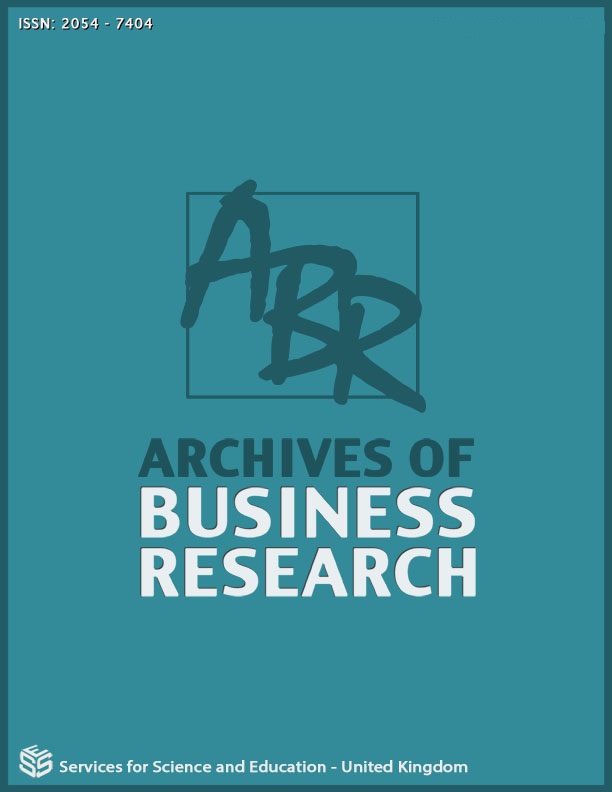The Role of Consumer Satisfaction in Mediating the Effect of Service Quality and Price Discount Framing on Hypermart Consumer Loyalty in the Province of Central Kalimantan, Indonesia
DOI:
https://doi.org/10.14738/abr.107.12787Keywords:
Service Quality, Price Discount Framing, Consumer Satisfaction, Consumer LoyaltyAbstract
Research in the field of marketing management aims to increase consumer loyalty by mediating consumer satisfaction, on the influence of service quality and price discount framing on consumer loyalty, either directly or indirectly, where customer satisfaction is an intervening variable. The research method used in this research is an associative-quantitative research approach. The population and sample in this study were customers or people who had shopped at a large supermarket Hypermart in Palangka Raya City in Indonesia. The number of research respondents was 105 hypermart customers. The results show that service quality has a positive and significant effect on consumer satisfaction, service quality has a positive and significant effect on consumer loyalty, price discount framing has a negative and insignificant effect on consumer satisfaction, price discount framing has a positive and significant effect on consumer loyalty, and consumer satisfaction has an effect on positive and significant impact on consumer loyalty, service quality has a positive and significant effect on consumer loyalty through customer satisfaction, and price discount framing has a positive and significant effect on consumer loyalty through customer satisfaction. The novelty of the price discount framing variable in increasing consumer loyalty, for further research can include the value innovation variable.
References
Aburayya, A., Marzouqi, A., Alawadhi, D., Abdouli, F., & Taryam, M. (2020). An empirical investigation of the effect of employees’ customer orientation on customer loyalty through the mediating role of customer satisfaction and service quality. Management Science Letters, 10(10), 2147-2158. 10.5267/j.msl.2020.3.022
Barton, R., Aibinu, A. A., & Oliveros, J. (2019). The value for money concept in investment evaluation: Deconstructing its meaning for better decision making. Project Management Journal, 50(2), 210-225. https://journals.sagepub.com/doi/abs/10.1177/8756972819827102
Carlson, J. P. (2018). Consumer evaluations of bonus packs offered with price discounts. Journal of Consumer Marketing. https://doi.org/10.1108/JCM-09-2015-1555
Cepeda-Carrion, G., Cegarra-Navarro, J. G., & Cillo, V. (2018). Tips to use partial least squares structural equation modelling (PLS-SEM) in knowledge management. Journal of Knowledge Management. https://www.emerald.com/insight/content/doi/10.1108/JKM-05-2018-0322/full/html
DAM, S. M., & DAM, T. C. (2021). Relationships between service quality, brand image, customer satisfaction, and customer loyalty. The Journal of Asian Finance, Economics and Business, 8(3), 585-593. https://www.koreascience.or.kr/article/JAKO202106438543453.page
Gardocka-Jałowiec, A., Szalonka, K., & Stańczyk, P. (2018). The determinants of shopping place selection in Poland–the survey results. Optimum. Economic Studies, (4 (94)), 274-285. https://repozytorium.uwb.edu.pl/jspui/handle/11320/7543
Hähnchen, A., & Baumgartner, B. (2020). The Impact of Price Bundling on the Evaluation of Bundled Products: Does It Matter How You Frame It?. Schmalenbach Business Review, 72(1), 39-63. https://link.springer.com/article/10.1007/s41464-020-00082-2
Iglesias, O., Markovic, S., Bagherzadeh, M., & Singh, J. J. (2020). Co-creation: A key link between corporate social responsibility, customer trust, and customer loyalty. Journal of Business Ethics, 163(1), 151-166. https://link.springer.com/article/10.1007/s10551-018-4015-y
Kalia, P., Kaur, N., & Singh, T. (2017). Consumer satisfaction in e-shopping: An overview. Indian Journal of Economics and Development, 13, 569-576. https://papers.ssrn.com/sol3/papers.cfm?abstract_id=2952897
Kotler, P., Keller, K. L., Ang, S. H., Tan, C. T., & Leong, S. M. (2018). Marketing management: an Asian perspective. Harlow: Pearson. https://d1wqtxts1xzle7.cloudfront.net/58052402
Kristinae, V., Sambung, R., & Sahay, M. (2019). The role of entrepreneurial orientation in product innovation in emerging markets on the local products. Oradea Journal of Business and Economics, 4(2), 35-44. http://ojbe.steconomiceuoradea.ro/wp-content/uploads/2019/10/OJBE_vol-42.pdf#page=35
Kurdi, B., Alshurideh, M., & Alnaser, A. (2020). The impact of employee satisfaction on customer satisfaction: Theoretical and empirical underpinning. Management Science Letters, 10(15), 3561-3570. 10.5267/j.msl.2020.6.038
Lee, L. C., Liong, C. Y., & Jemain, A. A. (2018). Partial least squares-discriminant analysis (PLS-DA) for classification of high-dimensional (HD) data: a review of contemporary practice strategies and knowledge gaps. Analyst, 143(15), 3526-3539. https://pubs.rsc.org/en/content/articlelanding/2018/an/c8an00599k/unauth
Medberg, G., & Grönroos, C. (2020). Value-in-use and service quality: do customers see a difference?. Journal of Service Theory and Practice. https://doi.org/10.1108/JSTP-09-2019-0207
Mo, Z., Ma, H., Wei, W., Wang, C., & Fu, H. (2019). When does the discount look more attractive: neural correlates of discount framing effect in the purchase of bundles. NeuroReport, 30(10), 718-724. https://doi.org/10.1097/WNR.0000000000001265
Purwanto, A., & Sudargini, Y. (2021). Partial least squares structural squation modeling (PLS-SEM) analysis for social and management research: a literature review. Journal of Industrial Engineering & Management Research, 2(4), 114-123. https://jiemar.org/index.php/jiemar/article/view/168
Qamari, I. N., Ferdinand, A. T., Dwiatmadja, C., & Yuniawan, A. (2020). Transformative interaction capability: the mediating role between quality of work life and teamwork performance. International Journal of Quality and Service Sciences, 12(2), 133-148. https://www.emerald.com/insight/content/doi/10.1108/IJQSS-01-2019-0008/full/html
Ramya, N., Kowsalya, A., & Dharanipriya, K. (2019). Service quality and its dimensions. EPRA International Journal of Research & Development, 4(2). https://www.researchgate.net/profile/Ramya-N/publication/333058377
Sparrow, R., Dartanto, T., & Hartwig, R. (2020). Indonesia under the new normal: Challenges and the way ahead. Bulletin of Indonesian Economic Studies, 56(3), 269-299. https://www.tandfonline.com/doi/full/10.1080/00074918.2020.1854079
Tan, C. N. L., Ojo, A. O., Cheah, J. H., & Ramayah, T. (2019). Measuring the influence of service quality on patient satisfaction in Malaysia. Quality Management Journal, 26(3), 129-143. https://doi.org/10.1080/10686967.2019.1615852
Vargo, S. L., & Lusch, R. F. (2014). Service-dominant logic: What it is, what it is not, what it might be. In The service-dominant logic of marketing (pp. 61-74). Routledge. https://www.sciencedirect.com/science/article/abs/pii/S0167811615302007
Vargo, S. L., & Lusch, R. F. (2017). Service-dominant logic 2025. International Journal of Research in Marketing, 34(1), 46-67. https://doi.org/10.1016/j.ijresmar.2016.11.001
Downloads
Published
How to Cite
Issue
Section
License
Copyright (c) 2022 Meitiana, Vivy Kristinae, Astuti Telaumbanua

This work is licensed under a Creative Commons Attribution 4.0 International License.






